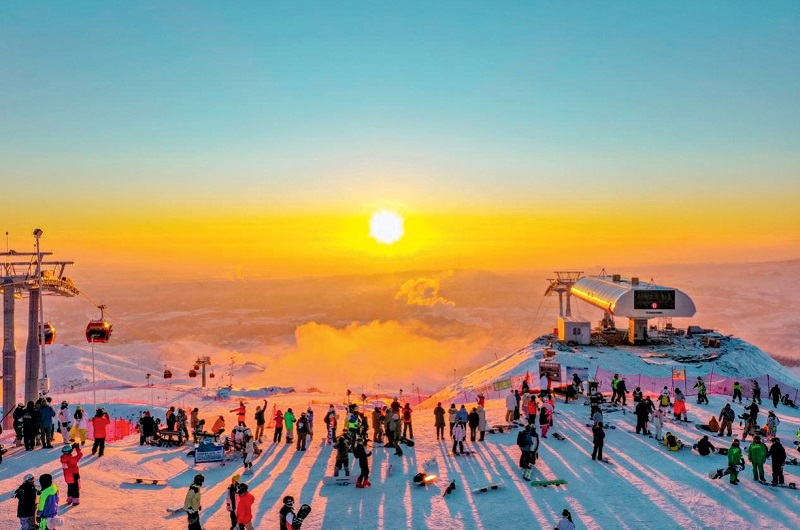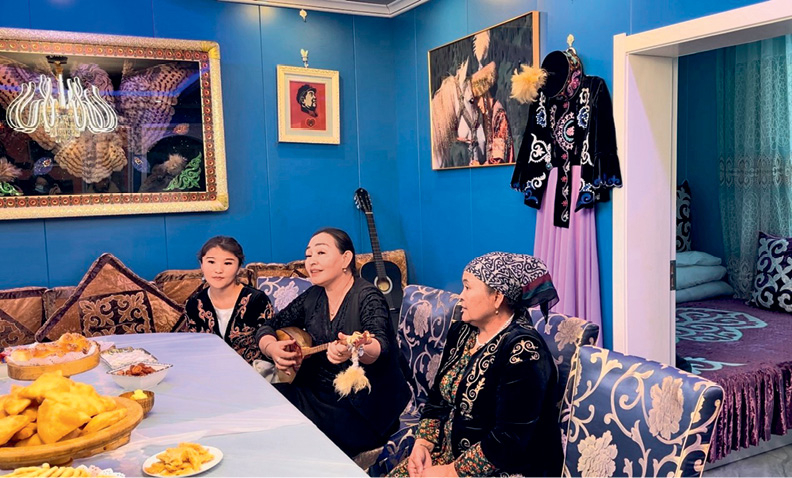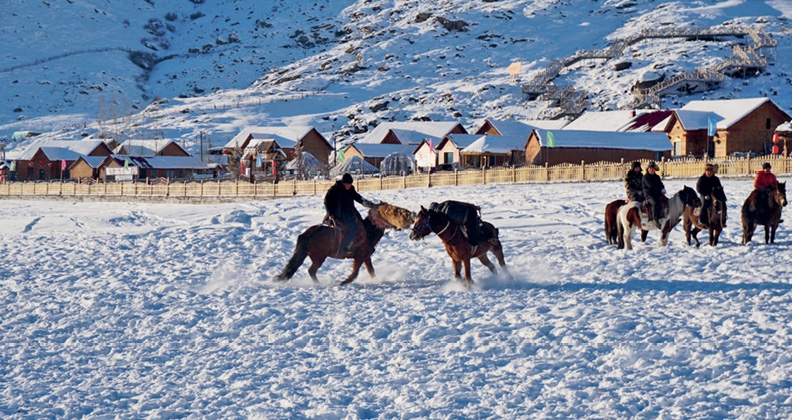Ice and snow tourism injects new momentum into rural revitalization and high-quality development in northwest China’s Xinjiang.

Skiers enjoy watching a sunset at the top of the Jiangjun Mountain International Ski Resort. Photo courtesy of Jiangjun Mountain International Ski Resort
Local temperatures reached minus 20 degrees Celsius in December 2023 in Altay, Xinjiang Uygur Autonomous Region, but such harsh weather did not hinder well-equipped enthusiasts from skiing in the local Jiangjun Mountain Ski Resort. Since its opening in November, the resort has received an average of more than 4,000 visitors per day, far exceeding that of the same period in previous years.
This is an epitome of Xinjiang’s ice and snow economy. Being rich in ice and snow resources, Xinjiang has devoted great energy to developing ice and snow sports and tourism, turning cold resources into hot economic gains.

Naziguli Lazidan, director of the tourist service center of Talate Village, plays a traditional ethnic instrument in a homestay named House on Horseback. Liu Ting
Improved Facilities
Built in 2009, Jiangjun Mountain Ski Resort is China’s only alpine ski resort inside a city. Only 1.6 kilometers away from the downtown, it is accessible in five minutes by shuttle bus. For the convenience of skiers, Altay City has also opened up direct flights to Beijing and Xi’an. There are also dedicated tourist trains facilitating skiers to travel between Urumqi and Altay City. The trains are specially equipped with luggage racks for storing ski equipment.
“Skiers of various technical levels can find trails that suit them from our 72 ski trails,” said Shi Zhiqiang, deputy general manager of Xinjiang Altay Tourism Development Group Co., Ltd. On December 9, 2023, the resort opened the BK Ski Park built by the HelvePark team from Switzerland and a local team. Skiers can enjoy the fun of skiing and try extreme maneuvers in this 30,000-square-meter space.
Koktokay International Ski Resort, opened in 2020, is another popular skiing destination in the Altay Prefecture. Operating from October to June annually, the resort boasts the longest skiing season in China. It has a maximum altitude of 3,100 meters and a maximum vertical drop of 1,350 meters.
“It’s an amazing skiing experience. It is suitable for long-distance skiing,” said Andreas, a German who has lived in China for 13 years and has visited many ski resorts, including those in Chongli adjacent to Beijing, and Yabuli in northeast China’s Heilongjiang Province.
According to Wang Miaomiao, deputy general manager of the ski resort, Koktokay plans to build 80 ski trails, and 27 have been built so far. The scenic spot now has a maximum daily reception capacity of 6,000 people, and has received more than 1 million tourists.
According to the Department of Culture and Tourism of Xinjiang Uygur Autonomous Region, as of December 20, 2023, there were 188 venues for ice and snow sports in Xinjiang, including 101 ski resorts, 27 ice skating venues, and 60 ice and snow amusement parks.

Tourists skiing down a slope at Koktokay International Ski Resort. Liu Ting
Creating New Businesses
Xinjiang’s skiing craze has led to a sharp increase in the number of ski instructors. Lyu Yaoping from southwest China’s Guangxi Zhuang Autonomous Region feels this change. She has been working as a ski instructor at Jiangjun Mountain Ski Resort since 2019. “There were just about 50 instructors in 2019, but now the number has grown to more than 180.”
The biggest change during this period has been the rising popularity of ice and snow sports. According to Lyu, many of her students are from local primary and secondary schools. Since 2018, Altay has incorporated skiing into the physical education content of primary and secondary school students. Every day, about 400 students go to the resort to learn how to ski, and the local education department pay for students’ skiing fees.
In 2023 Jiangjun Mountain Ski Resort partnered with the France-based Club Med resort franchise. French instructor David Guigaz and Russian instructor Marina Denisova from the elite ski instructor team of Club Med came to train coaches for the Chinese resort. “We hope to introduce an international teaching system, improve the teaching level of instructors, and provide better services to tourists,” said Shi.
According to Shi, the resort has been actively developing new projects according to public demand. After a skier posted a video taken at sunset at the top of the resort, the resort postponed the daily operation time of the ski lift so that skiers could stay on the mountaintop at sunset. Then, the idea of a “sunset party” at the Sunside Restaurant at the mountaintop was born. Now, dynamic music begins to play whenever the sun is about to set, the resort staff play DJ live music and lead a dance, and skiers take off their skis and dance along to the music.
Yu Momo, a ski enthusiast from Yinchuan, capital of northwest China’s Ningxia Hui Autonomous Region, has been to ski resorts in more than 20 countries. He found the huge development potential of Koktokay International Ski Resort, which provides one-stop service ranging from homestay to car rental.

The Meritorious Horse Team performs folk cultural activities for tourists. Liu Ting
Booming Ice-Snow Tourism
Talate is a husbandry village where the population is predominantly made up of Kazakh ethnic people. Blackcurrant planting and pasture husbandry used to be the main sources of income for the 778 villagers. After Koktokay International Ski Resort opened in 2020, a growing number of tourists have begun to stay in the village due to its close proximity to the ski resort.
Villager Kuliparan Habulihazi saw this business opportunity. With the support of the local government, she renovated her yurt and opened a homestay named House on Horseback. As soon as it opened, the Kazakh-style homestay attracted tourists from all over the country. According to Kuliparan, her homestay can bring an extra income of RMB 100,000 a year, which was unimaginable in the past.
“At first, villagers worried whether or not they would invest too much in tourism development with little results. We then carried out targeted skills training, such as catering and room service, which has greatly improved the level of tourism services. Ten demonstrative homestays have been built, providing models for villagers to do the business,” said Naziguli Lazidan, director of the tourist service center of Talate Village.
In addition, the village has also built a Meritorious Horse Team, which helps tourists understand the difficult years the village underwent in the past, and provides tourists with services such as horse riding and sightseeing. The horse team also combines Kazakh traditions with modern ice and snow activities, allowing tourists to experience the fun of ice and snow activities while experiencing the charm of Kazakh folk culture.
"At present, 180 villagers work at scenic spots and the ski resort. The per capita annual income of our village has reached RMB 23,000, of which the tourism income is RMB 16,000, accounting for 70 percent of the villagers’ total annual income,” said Shala Entemake, Party chief of Talate Village.
In recent years, the village has been holding special folk cultural tourism activities and bonfire parties on occasions of Kazakh festivities, receiving more than 150,000 tourists and generating a tourism income of RMB 2 million.
With booming ice and snow tourism in rural Xinjiang, more villagers find employment and business opportunities, injecting new momentum into rural revitalization and the high-quality development of the ice and snow economy.